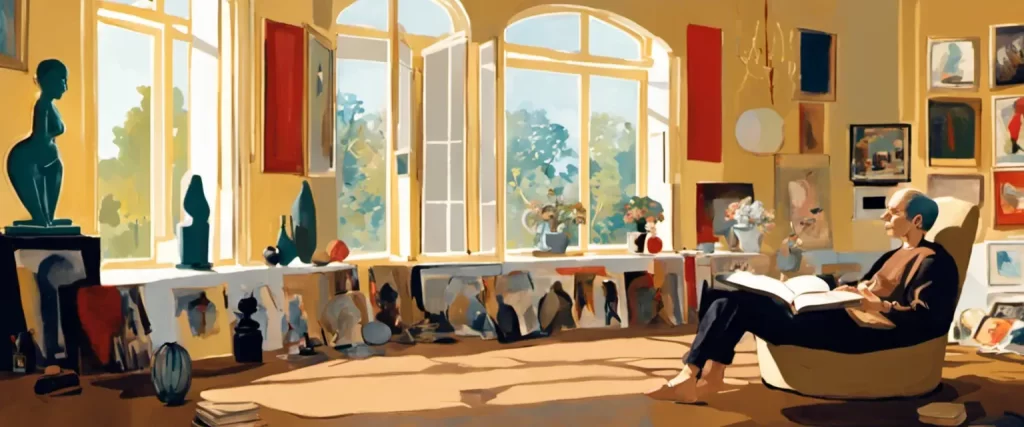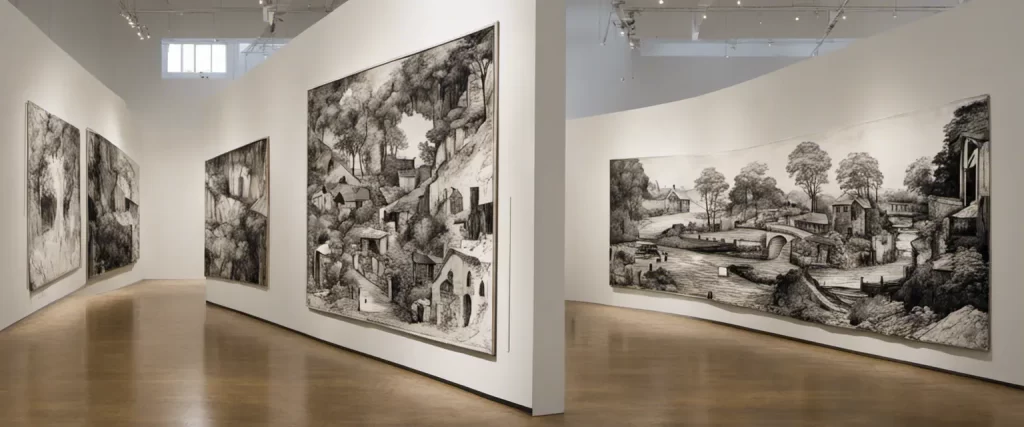——ways of seeing by John Berger & Art as Therapy by Alain de Botton
In the realm of art, the act of seeing extends beyond the mere observation of visual stimuli. It involves interpreting, understanding, and emotionally connecting with the artistic expressions presented before us. Two prominent books, “Ways of Seeing” by John Berger and “Art as Therapy” by Alain de Botton, delve deep into the complexities of perceiving art. Although distinct in their approaches, both authors aim to redefine the way we interact with and derive meaning from art. This comparative study will explore the fundamental principles and compelling insights offered by these two influential works, shedding light on the multifaceted nature of artistic perception.
John Berger’s seminal work, “Ways of Seeing,” published in 1972, focuses on decoding the visual language of art and its impact on our cultural understanding. As a renowned art critic, Berger challenges traditional art historical narratives and conventional modes of viewing by unveiling the underlying power dynamics and social constructs that subtly influence our perception. Through a combination of concise textual analysis and thought-provoking images, Berger unveils the ways in which society shapes our understanding of art, effectively dismantling the aura of authenticity surrounding pieces that are often presented as “masterpieces.”
On the other hand, Alain de Botton, a philosopher and art enthusiast, approaches art with a more introspective lens in his book “Art as Therapy,” released in 2013. Collaborating with art historian John Armstrong, de Botton suggests that art possesses immense therapeutic potential and can serve as a vehicle for emotional healing and personal reflection. By providing a new framework for engaging with art, de Botton positions it as a valuable mechanism for addressing universal human needs and desires, such as love, self-understanding, and consolation.
Through this comparative study, we aim to explore the distinctive perspectives presented by Berger and de Botton, considering both their similarities and differences in approaching art appreciation. By closely analyzing their ideas, we can uncover the transformative power of art and how it can shape our perception of the world, both individually and as a society.
This study intends to shed light on the various ways in which art can offer insights into human nature, foster empathy, and challenge established norms. Both Berger and de Botton present valuable insights into art’s role beyond aesthetics, emphasizing the importance of actively engaging with artwork to inspire personal growth and mindful contemplation.
By examining the principles outlined in “Ways of Seeing” and “Art as Therapy,” we hope to not only deepen our understanding of these two exceptional works, but also stimulate a broader conversation on the diverse ways art can inform, engage, and transform our lives.
In the subsequent chapters, we will delve into each author’s unique perspectives, analyzing their views on the function of art, the role of the viewer, and the potential for personal enrichment through engagement with artistic works. Through this exploration, we aim to provide a comprehensive understanding of the rich tapestry of human perception and interpretation that both Berger and de Botton offer to art lovers, scholars, and curious minds alike.
Keywords: art, perception, comparative study, Ways of Seeing, John Berger, Art as Therapy, Alain de Botton, visual language, cultural understanding, authenticity, therapeutic potential, engagement, transformative power.
Brief Summary of Two Books
ways of seeing by John Berger
Ways of Seeing” by John Berger is a thought-provoking book that challenges the traditional ways of looking at and interpreting art and images. Berger argues that our perception of images is heavily influenced by social and cultural constructs. He emphasizes that visual images are not neutral, but are shaped by the intentions and context in which they are created and consumed.
Through a series of short essays, Berger examines various aspects of visual culture, including oil paintings, advertisements, and photography. He critiques the traditional art world, arguing that it perpetuates a particular set of values and ideologies. Berger also explores how the treatment of women in art reflects societal attitudes towards gender and power.
One of Berger’s key arguments is that images have become deeply ingrained in our daily lives. He discusses how the prevalence of mass media and advertising has altered our relationship with images, turning them into commodities that are consumed and discarded without much thought.
Berger also explores the impact of reproductions and the loss of authenticity in the age of mechanical reproduction. He argues that reproductions of artworks, once intended to make art accessible to the masses, have become mere reproductions of status and power.
In “Ways of Seeing,” Berger challenges the reader to question the ways in which we actively, or passively, engage with images. He encourages us to critically examine the ideologies behind visual representations and consider alternative ways of looking.
Overall, “Ways of Seeing” offers a provocative exploration of the power and significance of visual images in our society and invites the reader to adopt a more critical and discerning gaze.
Art as Therapy by Alain de Botton
“Art as Therapy” by Alain de Botton and John Armstrong is a thought-provoking book that explores the ways in which art can serve as a therapeutic tool in our lives. The authors argue that rather than maintaining a distant and exclusive relationship with art, we should actively engage with it as a means of addressing our emotional and psychological needs.
The book is divided into chapters, each focusing on a different aspect of human experience, such as love, nature, work, and self-understanding. Within each chapter, de Botton and Armstrong examine how art can help us navigate these aspects and enhance the quality of our lives.
They believe that art should be more than just a museum piece, but instead, it should be integrated into our everyday existence. By presenting numerous examples of different artworks, they illustrate how art can help us cultivate empathy, provide solace in times of grief, guide us in understanding love and relationships, and help us reconnect with nature.
De Botton and Armstrong propose that art can act as a form of therapy, heightening our self-awareness and enabling us to better understand our emotions and experiences. They suggest that by carefully selecting artworks and engaging with them intentionally, we can find personal insights and reflections that can lead to self-improvement and growth.
Ultimately, “Art as Therapy” encourages readers to reconsider their relationship with art and begin to see it as a practical tool that can assist in our daily lives, offering guidance and solace in the face of life’s challenges. Through their insightful analysis, the authors demonstrate the transformative potential of art and its ability to enhance our overall well-being.
Comparison between Two Books

Similarities in Plastic & Visual Arts
In both “Ways of Seeing” by John Berger and “Art as Therapy” by Alain de Botton, there are parallel perspectives on plastic and visual arts that can be observed.
1. Challenging traditional ideals: Both authors question the conventional notions surrounding visual arts. Berger argues that these arts have historically been used as a form of power and to perpetuate the status quo. Similarly, de Botton challenges the traditional belief that art should only be appreciated for its aesthetic value, asserting that it should also serve a therapeutic purpose for individuals and society as a whole.
2. Breaking down the distinction between high and low art: Berger and de Botton both aim to break down the distinction between high art, often associated with prestigious institutions, and low art, which includes everyday objects or mass-produced works. They emphasize the idea that art is everywhere and has the capacity to be found in even the most mundane aspects of life.
3. Encouragement of active engagement: Both authors advocate for active engagement with art, rather than a passive, detached observation. Berger proposes that art should be experienced in person rather than solely through reproductions, as it allows for a more direct and personal interaction. De Botton suggests that art can be transformative when individuals engage with it on a personal level, allowing it to offer insights and guidance.
4. Contextualizing art within society: Berger and de Botton contextualize art within society, highlighting its role as a reflection of cultural values and social issues. They argue that art can be a tool for understanding history, politics, and the human experience, offering possibilities for social critique and change.
5. Emotional and psychological impact: Both authors delve into the emotional and psychological impact that visual arts can have on individuals. Berger explores the historical representation of women in art, emphasizing the psychological impact it had on their perception and position in society. De Botton suggests that art can serve as a form of therapy, offering solace, guidance, and a means to express and examine emotions.
While there may be differences in the specific theories and arguments presented by Berger and de Botton, the above similarities demonstrate a parallel reflection on plastic and visual arts within their respective works. Both authors challenge traditional perspectives, break down artificial hierarchies, emphasize active engagement, contextualize art in society, and explore the emotional and psychological impact of visual arts.
Divergences in Plastic & Visual Arts
“Ways of Seeing” by John Berger and “Art as Therapy” by Alain de Botton are both influential books that explore the world of art and its impact on individuals and society. While they share some similarities in terms of their focus on the importance of art, they diverge when it comes to the discussion of plastic and visual arts.
In “Ways of Seeing,” Berger examines the historical and social context of visual images and how they shape our perception of the world. He delves into the ideas of ownership, power, and the male gaze in art, challenging traditional interpretations and encouraging the viewer to question the meanings embedded within. Although plastic and visual arts are referenced in his work, Berger largely focuses on classical paintings and the historical significance they hold.
On the other hand, “Art as Therapy” by Alain de Botton takes a more contemporary approach, discussing how art can be utilized as a means of therapy and personal growth. The book aims to demonstrate how visual art can provide solace, guidance, and emotional fulfillment in our everyday lives. De Botton argues that art can serve as a tool for self-reflection, dealing with personal troubles, and fostering individual well-being. His exploration of art as therapy extends to various mediums, including sculpture, photography, and video installations.
The divergence between these two books regarding plastic and visual arts lies in their emphasis and approach. Berger’s “Ways of Seeing” focuses on the historical and cultural dimensions of art, arguing that the meaning behind visual images is deeply rooted in societal structures. While he acknowledges the technical aspects of plastic arts, such as the way paintings are created using pigments and molds, his primary concern lies in the ideology of art rather than its materiality.
In contrast, de Botton’s “Art as Therapy” embraces a more personal and therapeutic perspective, considering how visual art can directly influence our emotions and mental well-being. He discusses how the physicality and material qualities of plastic and visual arts, such as textures, colors, and forms, can have a profound impact on our emotions and provide healing experiences. De Botton’s focus on the therapeutic potential of art extends beyond the traditional art world, encompassing everyday objects and experiences.
While both books share a common interest in art and its significance, they diverge when it comes to the discussion of plastic and visual arts. Berger’s “Ways of Seeing” explores the historical and cultural contexts of art, while de Botton’s “Art as Therapy” explores the personal and therapeutic aspects of art, including the physicality of plastic and visual arts.

Conclusion
Determining which book is more worthy of reading is subjective and depends on an individual’s personal interests and preferences. Both “Ways of Seeing” by John Berger and “Art as Therapy” by Alain de Botton offer unique perspectives on art and its role in our lives.
“Ways of Seeing” is a seminal text that explores how our perception of art is shaped by various factors, including societal influence, historical context, and our own individual biases. Berger’s book critiques traditional art appreciation and encourages the reader to question established norms, making it a significant contribution to art theory and criticism.
On the other hand, “Art as Therapy” by Alain de Botton focuses on the transformative power of art in our daily lives. The book suggests that art can serve as a therapeutic tool, helping us to better understand ourselves, cope with emotions, and find solace. De Botton and his collaborator, John Armstrong, provide practical examples and exercises to guide readers in using art as a personal tool for growth and self-reflection.
Ultimately, whether one book is more worthy of reading than the other depends on your personal interests and goals. If you are more interested in critically analyzing the social and cultural aspects of art, “Ways of Seeing” may be the better choice for you. However, if you are seeking a book that explores the emotional and personal impact of art, “Art as Therapy” could be a more suitable option.
Consider your own interests, goals, and the type of insight you are seeking before deciding which book to read. Both texts offer valuable perspectives on art, and you may find it beneficial to read and explore ideas from both books.



